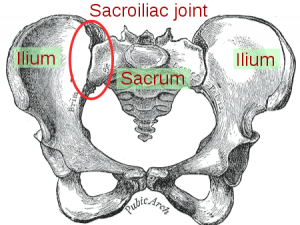Purpose
The sacral thrust test is a pain provocation test used to diagnose sacroiliac dysfunction. One single positive test does not have high diagnostic accuracy but a combination with other sacroiliac pain provocation tests gives valid evidence for sacroiliac dysfunction.
The test is also known as:
- Sacral compression test
- Downwards pressure test
- Sacral spring test
Technique
With the patient prone, the examiner applies an anteriorly directed pressure over the sacrum. One hand is placed directly on the sacrum and is being reinforced by the other hand. Purpose is to apply an anterior shear force to both sacroiliac joints since the ilia are fixed by the examination bench. The test is positive if pain is reproduced in the sacroiliac region. [1][2]
Evidence
The gold standard to evaluate sacroiliac pain provocation tests is an intra-articular injection of a local anesthetic into the sacroiliac joint, under the guidance of radiological imaging. [3] A specified level of pain reduction (70-90%) must be accomplished. There are however some problems related to the use of this gold standard: [4]
- Only intra-articular pain sources are investigated
- Not all structures of the joint capsule are affected
- The use of a needle may cause or increase pain
Many pain provocation tests for the sacroiliac region exist and have been subject to clinical research. There is however no consensus on how to endorse clinical decision-making. Grade A recommendation based on 3 level 1B studies identifies 4 to 5 tests with highest specifciity and sensitivity among known sacroiliac pain provocation tests and acceptable intertester reliability to be included in the clinical examination: [1][4]
Laslett et al (2005) state that no further examination is wishful if both distraction and thigh trust test provoke familiar pain. If only one test or 2 other tests are positive, further testing is required to obtain a valid result. Values for diagnostic utility can be found here.
The sacral thrust test has a moderate intertester reliability of 74 (kappa=0,52 and p
| PPV | 56% |
| NPV | 80% |
| Sensitivity | 63% |
| Specificity | 75% |
Resources
- M Laslett et al. Diagnosis of Sacroiliac Joint Pain: Validity of individual provocation tests and composites of tests. Manual Therapy 2005; 10:207-218
- CC Yung, M Fredericson, M Smuck. Sacroiliac Joint Pain Syndrome in Active Patients – A Look Behind the Pain. The Physician and Sports Medicine 2002; 30(11)
- JK Freburger, DL Riddle. Using published evidence to guide the examination of the sacroiliac joint region. Phys Ther. 2001; 81:1135–1143
- BA Zelle, GS Gruen, S Brown, S George. Sacroiliac dysfunction: evolution and management. Clin J Pain. 2005; 21(5):446-455
- JK Freburger, DL Riddle. Using Published Evidence to Guide the Examination of the Sacroiliac Joint Region. Physical Therapy. 2001; 81(5):1135-1143
- MT Cibulka, R Koldehoff. Clinical usefulness of a cluster of sacroiliac joint tests in patients with and without low back pain. J Orthop Sports Phys Ther. 1999; 29(2):83-89.
- P Dreyfuss, M Michaelsen, K Pauza, J McLarty, N Bogduk. The value of medical history and physical examination in diagnosing sacroiliac joint pain. Spine. 1996; 21(22):2594-2602.
References
- ↑ 1.01.1 NA Broadhurst, MJ Bond. Pain provocation tests for the assessment of sacroiliac joint dysfunction. J Spine Disorders. 1998; 11(4):341–345
- ↑ P Vercellini. Chronic pelvic pain. Wiley-Blackwell 2011: 118-119
- ↑ M Laslett. Pain provocation sacroiliac joint tests: reliability and prevalence. In: Vleeming A, Mooney V, Snijders CJ, Dormann TA, Stoeckart R, editors. Movement, Stability and Low Back Pain: The Essential Role of the Pelvis. 1st ed. New York: Churchill Livingstone; 1997
- ↑ 4.04.1 P Van der Wurff, RHM Hagmeijer, W Meyne. Clinical tests of the sacroiliac joint. A systematic methodological review. Manual Therapy 2000; 5(2):89-96


